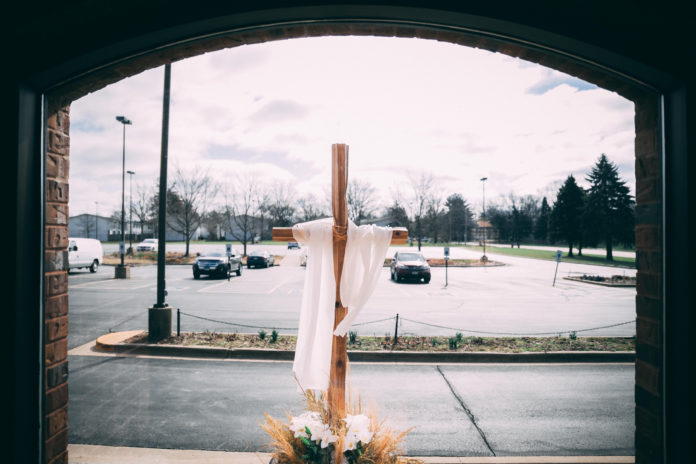(RNS) — Last year on March 3, the Rev. Wolfgang Herz-Lane got a call at home from a member of his congregation.
“That guy they’re talking about in the news,” the congregant said, “that’s me.”
He was referring to news reports about the first North Carolinian to be diagnosed with COVID-19. That person, who declined to be identified, is a member of Herz-Lane’s church, Christ the King Lutheran in Cary, a town west of Raleigh, the capital.
Herz-Lane said the man recovered and is doing well.
So is the church.
The congregation held its last indoor service a few days after that call. But it has not spent the past year standing still. The pandemic has transformed the 1,570-member church.
A few months into the pandemic, the congregation decided it would transition permanently to a “hybrid” model, conducting online worship that will continue even after in-person worship returns April 25 for 50 preregistered congregants.
A few weeks ago, it welcomed its first nonresident member, a Maryland woman who does not expect to worship in person but was able to attend the required new-member class online.
There’s also a new prayer garden and a labyrinth walk— for those who live nearby but don’t want to risk an indoor service.
The coronavirus has “redefined for me what church is going to be like and what the definition of membership is,” said Herz-Lane.
Exactly how the COVID-19 pandemic has reconfigured American religion is not yet clear. A recent Gallup poll suggested the virus was at least partly responsible for pushing formal church membership past what some regard as an alarming tipping point: Fewer than half of American Christians, Gallup reported, now belong to a church.
But as U.S. Christians celebrate a second Easter under pandemic rules — their own or those imposed by government or denominational guidelines — churches are reckoning with new ways of volunteering, stewardship and, above all, worshipping. Many will be looking at Easter services this year and wondering if they are not glimpsing the future of the church.
“The truth is, those numbers have been declining for 50 years,” said Herz-Lane. “The pandemic accelerated trends that are already there.”
Some churches are not giving in to any new normal quite yet. The nearly 300-year-old Old South Union Church, a United Church of Christ outpost in Weymouth, Massachusetts, has gone back and forth over the past year, both meeting online and holding hybrid services, with a fraction of their 500 members in the pews, with most watching from home.
On Easter, however, Old South Union will go back to online only, ceding the sanctuary to a full-blown Easter service with traditional choirs, including a bell choir and brass ensemble. “One of our deacons put it well,” said the Rev. Jennie Barrett Siegal, the senior pastor. “We wanted to have a service that felt like Easter, not just another service that happened to fall on Easter.”
Other congregations have no choice but to improvise their celebration. Before the pandemic, the Anthology Church, a Southern Baptist congregation in the Studio City neighborhood of Los Angeles, had been meeting in a local community center on Sundays. With the center still closed despite the gradual lifting of restrictions by the city, Anthology’s pastor, the Rev. D.J. Jenkins, began scouting for a church where his flock could hold an outdoor service.
All of the churches he called declined. Undaunted, he reached out to the rabbis at two synagogues that participate with Anthology in a local interfaith food pantry. This Sunday, Jenkins will lead an Easter service on the grounds of Temple Beth Hillel, a Reform congregation.
Though Easter normally draws about 200 worshippers, Sunday’s gathering will be limited to about 50, with masks and temperature checks required. The hymns will be played on a single guitar and a cajón, a box-shaped percussion instrument.
As unfamiliar and modest as Easter will be, Jenkins will be grateful just to be together. “It’s going to be, ‘Oh my gosh, we are all together and we are singing,’” he said. “It’s going to be therapeutic in that regard.”
Different doesn’t always mean diminished; the pandemic has pushed some churches to broaden their appeal. St. John’s Lutheran Church in Elkhorn, Wisconsin, part of Lutheran Congregations in Mission for Christ, has found glimmers of hope in the church’s annual Easter egg hunt.
Normally an Easter-morning affair that brought out a few dozen families from the congregation to search for prize-filled plastic eggs, this year’s hunt has turned into a weeklong text message-based scavenger hunt that has pushed congregants out into the community and involved people who had never come to the church.
A banner outside St. John’s gives the first clue to the Easter Jam Family Egg Hunt, explained Stephen Quist, who co-leads the church’s children and family ministry with his wife, Cassie. By texting clues to a phone number on the banner, participants are led to a dozen or so locations around town and eventually back to church, where they get a prize pack full of Easter eggs and candy, as well as information about the church’s Easter Sunday services — online, outdoors and in the sanctuary.
Quist said a couple dozen families, including some who don’t attend St. John’s, already had participated in the scavenger hunt as of Tuesday morning (March 30).
St. John’s already was thinking of moving away from its traditional Easter egg hunt to try new things when COVID-19 hit last year, he said. Now it has found a new activity that involves the whole community. “I would say that COVID has maybe expedited, forced our hand in the direction we’re probably headed anyway,” Quist said.

